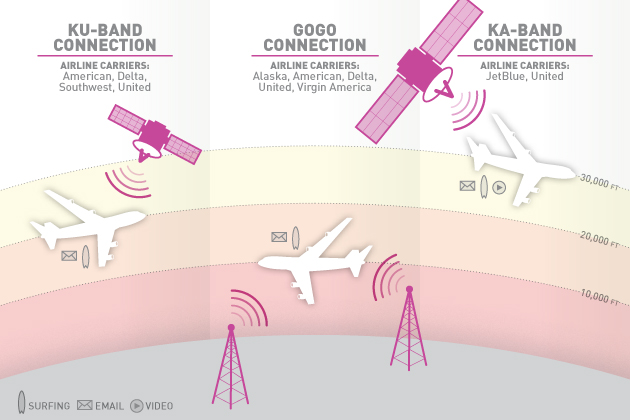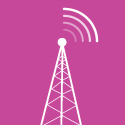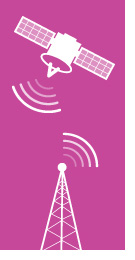A traveler's guide to in-flight WiFi

You're on a nice, long domestic flight. In coach. There's a screaming baby two rows up; the pages of the in-flight magazine are stuck together with someone else's chewing gum; and the 9-inch overhead CRT is showing a 2-year-old episode of New Girl that you've already seen a half-dozen times -- without sound, because you always end up in the seat with a broken headphone jack. Oh, and you have five hours left to go to LAX.
If you play your cards right (and pack some noise-canceling headphones), your next cross-country haul could be a whole lot more pleasant, thanks to in-flight WiFi. Nearly all of the major US airlines now offer WiFi in the sky. Thousands of passengers flying above North America are online right now, watching adorable kittens meow on YouTube, reading up on their destinations or researching a new device right here on Engadget. But while some carriers offer service on many of their planes, few have it available fleet-wide, making it difficult to plan your travel around connectivity. So, which airlines offer the best service and how can you sort what you'll have on board? Join us here as we explore the turbulent world of WiFi at 30,000 feet.
HOW IT WORKS

The technology getting you online in the air is actually very straightforward, functioning in much the same way as it does when you're sitting at home. The biggest challenge is maintaining a connection as an aircraft barrels through the stratosphere at 600 miles per hour. Regardless of whether the plane is pulling data from a tower on the ground or a satellite far above, it moves between cell sites or satellite beams throughout a flight, requiring frequent handoffs. And while your roof-mounted dish is stationary, an airplane travels horizontally, vertically and at an angle, requiring a special antenna that rotates under its dome with every movement of the plane, or, in the case of Gogo, one installed just below the cargo hold.
Assuming a plane doesn't leave its coverage area, satellite services, such as Panasonic's eXConnect, Row 44's Ku-band solution or ViaSat's speedier Ka-band Exede, maintain a line-of-sight connection with the aircraft from the moment it leaves the gate to when it lands at its destination. The rotating antenna is mounted on the top of the plane, and the signal travels from the jet to a satellite orbiting some 22,000 miles above the Earth and back again in a bit over half a second. You may notice this delay when loading a page for the first time, but it won't have any effect on video streaming, which stores a few seconds of video on your laptop or tablet in a process called buffering.
The biggest challenge is maintaining a connection as an aircraft barrels through the stratosphere at 600 miles per hour.
The current version of Gogo, meanwhile, uses antennas mounted on the bottom, which communicate with a network of 160 cellphone towers positioned throughout North America. These towers are similar to what your smartphone connects to on the ground, but with antennas that point up instead of out to the side. Because the plane is much closer to these towers than it is to satellites in orbit, there's significantly less latency. Still, while text or compressed images on a web page may load right away, larger files often take much longer to appear than they do with a satellite connection. Also, an antenna on the bottom means you can only get online when your plane's in the air; satellites are connected while you're still on the ground.
Airlines may use a mix of any of the above networks. United, for example, offers service from Gogo, Panasonic or ViaSat, depending on the aircraft you fly. Despite having the greatest number of partners, however, the majority of the carrier's fleet doesn't offer internet at all. Older planes like the Boeing 747 have WiFi, while a brand-new aircraft like the 787 Dreamliner, which features United's latest cabin design, does not. Understandably, this causes significant confusion with customers, who, more often than not, don't know if there will be WiFi on their flight. Add to this frequent downtime and inconsistent pricing (even within the same airline), and it's easy to understand why travelers are frustrated with the experience.
Frontier, Hawaiian and Spirit have yet to add WiFi to their fleets, but most other US-based carriers have it installed. Let's break it down.
ALASKA AIRLINES
 If you're traveling aboard Alaska, you'll most likely be able to hop online above 10,000 feet every time you fly. The airline's partnered with Gogo to outfit nearly all of its 737s with air-to-ground connectivity.Pricing ranges from $5 for one hour of access to $16 for 24 hours, including connecting flights also operated by Alaska. Keep in mind that while Gogo can get you online as you travel throughout the continental US and Alaska, you'll be in the dark en-route to Hawaii and as you travel over parts of Canada. Gogo's service isn't the fastest in the sky, but Alaska scores big points for consistency -- popular business routes are covered from start to finish, and a standard pricing model is in place across the fleet.
If you're traveling aboard Alaska, you'll most likely be able to hop online above 10,000 feet every time you fly. The airline's partnered with Gogo to outfit nearly all of its 737s with air-to-ground connectivity.Pricing ranges from $5 for one hour of access to $16 for 24 hours, including connecting flights also operated by Alaska. Keep in mind that while Gogo can get you online as you travel throughout the continental US and Alaska, you'll be in the dark en-route to Hawaii and as you travel over parts of Canada. Gogo's service isn't the fastest in the sky, but Alaska scores big points for consistency -- popular business routes are covered from start to finish, and a standard pricing model is in place across the fleet.
Service: Gogo | Price: from $5 per hour | Availability: most 737s
AMERICAN AIRLINES
 American Airlines, which now also includes US Airways' fleet, offers Gogo service on many domestic flights. If you're traveling overseas, however, you'll need to fly American's new 777-300ER, which can get you online via satellite throughout many international flights. Domestic Gogo pricing matches Alaska's above, at $5 per hour or $16 for a full day, while international WiFi will run you $12 for two hours, $17 for four hours or $19 for the entire flight. As of this report, AA's latest 777 only flies from New York, Los Angeles and Dallas to London and Sao Paulo. Generally, many of American's 737s offer service, too, but to ensure connectivity, look for the WiFi insignia when booking a flight.
American Airlines, which now also includes US Airways' fleet, offers Gogo service on many domestic flights. If you're traveling overseas, however, you'll need to fly American's new 777-300ER, which can get you online via satellite throughout many international flights. Domestic Gogo pricing matches Alaska's above, at $5 per hour or $16 for a full day, while international WiFi will run you $12 for two hours, $17 for four hours or $19 for the entire flight. As of this report, AA's latest 777 only flies from New York, Los Angeles and Dallas to London and Sao Paulo. Generally, many of American's 737s offer service, too, but to ensure connectivity, look for the WiFi insignia when booking a flight.
Service: Gogo, satellite (int'l) | Price: from $5 per hour | Availability: 737, some 767s, 777s
DELTA AIR LINES
 Delta has a tremendous number of airplanes online -- more than 850, in fact. Gogo's providing service, so expect pricing to come in at $5 per hour or $16 for a full day, just as with the airlines above. Even some of Delta's international aircraft appear to be Gogo-equipped, but overseas service is via third-party satellites, and often pricier than what you'll pay for domestic use. Native (air-to-ground) Gogo service is available on domestic routes, including those within Alaska. Expect pages to load slower than what you're used to at home, but if email and basic web surfing are what you're after, you should have a generally positive experience. Delta identifies WiFi-equipped flights with a special insignia, so keep an eye out for that during the booking process.
Delta has a tremendous number of airplanes online -- more than 850, in fact. Gogo's providing service, so expect pricing to come in at $5 per hour or $16 for a full day, just as with the airlines above. Even some of Delta's international aircraft appear to be Gogo-equipped, but overseas service is via third-party satellites, and often pricier than what you'll pay for domestic use. Native (air-to-ground) Gogo service is available on domestic routes, including those within Alaska. Expect pages to load slower than what you're used to at home, but if email and basic web surfing are what you're after, you should have a generally positive experience. Delta identifies WiFi-equipped flights with a special insignia, so keep an eye out for that during the booking process.
Service: Gogo, satellite (int'l) | Price: from $5 per hour | Availability: all domestic, some int'l
JETBLUE
 A latecomer to the connected age, JetBlue began offering satellite service on select Airbus A320s just last year. Thanks to ViaSat-1 and its super-fast connection, the airline's fleet offers bandwidth that's consistent with what you're used to getting on the ground, which means you can even stream video from YouTube or Netflix without issue. The challenge here is figuring out how to book a WiFi-equipped flight. JetBlue only has a few dozen planes online so far, with a complete list of tail numbershere. The easiest way to tell if your flight has Fly-Fi (that's what JetBlue's calling it) is to pull up this page the night before you fly. There you'll find a complete list of the next day's WiFi flights. Pricing has yet to be finalized, but a free version is on offer for the time being, with Fly-Fi Plus streaming service available for a somewhat-ambitious $9 per hour.
A latecomer to the connected age, JetBlue began offering satellite service on select Airbus A320s just last year. Thanks to ViaSat-1 and its super-fast connection, the airline's fleet offers bandwidth that's consistent with what you're used to getting on the ground, which means you can even stream video from YouTube or Netflix without issue. The challenge here is figuring out how to book a WiFi-equipped flight. JetBlue only has a few dozen planes online so far, with a complete list of tail numbershere. The easiest way to tell if your flight has Fly-Fi (that's what JetBlue's calling it) is to pull up this page the night before you fly. There you'll find a complete list of the next day's WiFi flights. Pricing has yet to be finalized, but a free version is on offer for the time being, with Fly-Fi Plus streaming service available for a somewhat-ambitious $9 per hour.
Service: Satellite | Price: free or $9 per hour | Availability: select A320s
SOUTHWEST AIRLINES
 It shouldn't come as a surprise that Southwest does things a little differently. The airline's WiFi service, installed on more than 425 planes and available gate to gate, is provided by Row 44, which uses Hughes' network of satellites. Service costs $8 per day (including multiple flights) and comes with free access to 17 channels of streaming TV. Southwest will also offer WiFi on international flights beginning this summer, albeit without the free TV. The airline's subsidiary, AirTran, uses Gogo's air-to-ground service instead, with prices ranging from $5 per hour to $16 for a full day.
It shouldn't come as a surprise that Southwest does things a little differently. The airline's WiFi service, installed on more than 425 planes and available gate to gate, is provided by Row 44, which uses Hughes' network of satellites. Service costs $8 per day (including multiple flights) and comes with free access to 17 channels of streaming TV. Southwest will also offer WiFi on international flights beginning this summer, albeit without the free TV. The airline's subsidiary, AirTran, uses Gogo's air-to-ground service instead, with prices ranging from $5 per hour to $16 for a full day.
Service: Satellite | Price: $8 per day | Availability: most 737s
UNITED AIRLINES
 Until last year, United only offered WiFi on flights from New York's JFK airport to Los Angeles and San Francisco. That version, provided by Gogo, is still available today. If you're flying on one of UA's Airbus A319s or A320s in the US, however, you'll probably find Panasonic's WiFi, as will passengers traveling on a Boeing 747 to destinations abroad. Complicating matters even further, United recently began offering ViaSat WiFi (the same version you'll find on JetBlue). This latest offering should be very fast -- when it works (I only got as far as that error page above on a recent flight) -- and it's currently rolling out to the airline's Boeing 737s. Gogo service starts at $5 per hour, while you'll pay a flat fee depending on the length of your flight for satellite internet.
Until last year, United only offered WiFi on flights from New York's JFK airport to Los Angeles and San Francisco. That version, provided by Gogo, is still available today. If you're flying on one of UA's Airbus A319s or A320s in the US, however, you'll probably find Panasonic's WiFi, as will passengers traveling on a Boeing 747 to destinations abroad. Complicating matters even further, United recently began offering ViaSat WiFi (the same version you'll find on JetBlue). This latest offering should be very fast -- when it works (I only got as far as that error page above on a recent flight) -- and it's currently rolling out to the airline's Boeing 737s. Gogo service starts at $5 per hour, while you'll pay a flat fee depending on the length of your flight for satellite internet.
Service: Gogo, satellite (int'l) | Price: from $5 per hour | Availability: A319, A320, 747, some 737s, 757
VIRGIN AMERICA
 Virgin America's fleet currently consists of just over 50 Airbus A319s and A320s, and every single one of them is equipped with Gogo's air-to-ground service. The same Gogo pricing above applies here: $5 per hour or $16 per day. You'll be able to connect for entire flights that don't leave the country. If you're flying Virgin to Mexico, however, you'll only have WiFi within 100 miles of the US border. And, unlike some of the other airlines listed above, Virgin America has power outlets at every seat on every plane, so you can juice up as you surf to your heart's content.
Virgin America's fleet currently consists of just over 50 Airbus A319s and A320s, and every single one of them is equipped with Gogo's air-to-ground service. The same Gogo pricing above applies here: $5 per hour or $16 per day. You'll be able to connect for entire flights that don't leave the country. If you're flying Virgin to Mexico, however, you'll only have WiFi within 100 miles of the US border. And, unlike some of the other airlines listed above, Virgin America has power outlets at every seat on every plane, so you can juice up as you surf to your heart's content.
Service: Gogo | Price: from $5 per hour | Availability: all
THE BOTTOMLINE

With few exceptions, you're going to need to employ some careful planning to guarantee connectivity on your next flight. While some airlines, like Alaska, AA, Delta, Southwest and Virgin have WiFi on nearly all of their domestic planes, others are hit or miss. Even if your plane has a WiFi sticker on the fuselage and a wireless signal on board, you may still run into some issues getting online. All of the service providers have maintenance facilities around the country, but planes may need to be scheduled for repairs days or weeks in advance -- if something goes wrong, there could be dozens of flights before a technician manages to get on board.
With few exceptions, you're going to need to employ some careful planning to guarantee connectivity on your next flight.Fortunately, if you're flying with a new airline or internet provider, you can take the service for a free spin to get a feel for performance before pulling out your credit card and committing to an entire flight. Airlines often offer free access to their own websites or the sites of select retail partners, and if you have a pleasant experience browsing there, that's generally representative of the speeds you'll see with a paid plan. You probably won't get a great feel for how streaming video will perform until you pay, but unless you're on a JetBlue or United flight with ViaSat's Ka-band service, you can rule out YouTube, Netflix or Hulu.
With speedy service from ViaSat and faster offerings from Gogo on the horizon, it's definitely an exciting time for in-flight communication. Even services like two-way callingare possible, but are currently (and hopefully forever) banned. Some people love having an excuse to disconnect, and if that's you, you're going to want to book a plane that doesn't have WiFi, while they're still on offer. For the rest of us, though, there are more options than ever to get online in the sky.

No comments:
Post a Comment